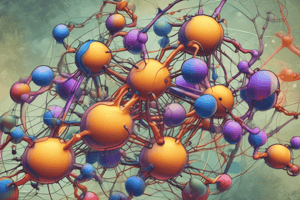Podcast
Questions and Answers
What is characterized by a drug binding to a receptor and producing a biologic response due to strong affinity?
What is characterized by a drug binding to a receptor and producing a biologic response due to strong affinity?
- Physiological antagonism
- Antagonism
- Chemical antagonism
- Agonism (correct)
Which drug competes with purine bases and interferes with DNA synthesis?
Which drug competes with purine bases and interferes with DNA synthesis?
- Prazosin
- Sulfonamide antibiotics
- Propranolol
- 6-mercaptopurine (6-MP) (correct)
What defines an antagonist in terms of drug-receptor interaction?
What defines an antagonist in terms of drug-receptor interaction?
- Low affinity, high efficacy
- High efficacy, low affinity
- Affinity and zero efficacy (correct)
- No affinity, no efficacy
Which of the following types of antagonism involves the direct interaction between two drugs?
Which of the following types of antagonism involves the direct interaction between two drugs?
What is the implication of a drug having zero efficacy?
What is the implication of a drug having zero efficacy?
What role do enzymes play in the body?
What role do enzymes play in the body?
What is the effect of certain drugs on enzyme activity?
What is the effect of certain drugs on enzyme activity?
Which process is described as 'What the DRUG does to the BODY'?
Which process is described as 'What the DRUG does to the BODY'?
In pharmacodynamics, what does inhibition imply?
In pharmacodynamics, what does inhibition imply?
What is the primary purpose of drugs that inhibit enzymes?
What is the primary purpose of drugs that inhibit enzymes?
Study Notes
Inhibition of Enzymes
- Enzymes facilitate chemical reactions and are crucial for metabolic processes.
- Some drugs inhibit enzyme activity, impacting physiological responses.
- Example of an anticancer agent: 6-mercaptopurine (6-MP) competes with purine bases, hindering DNA synthesis and cell division.
- Sulfonamide antibiotics inhibit folic acid synthesis by competing with PABA in bacteria.
Pharmacodynamics of Drugs
- "What the DRUG does to the BODY" refers to the drug's effects and mechanisms of action.
- Drug action involves binding to receptors with varying affinity and efficacy.
- Agonists have both affinity and efficacy, while antagonists possess affinity but no efficacy (e.g., Prazosin and propranolol).
Types of Antagonism
- Chemical Antagonism: Involves the interaction of two substances.
- Physiological Antagonism: An antagonist acts at a separate receptor to produce opposing effects (e.g., nicotine's effect on acetylcholine receptors).
- Pharmacological Antagonism: Direct blocking of a receptor.
Types of Non-Competitive Block
- Reversible Antagonism: Antagonists bind temporarily, leading to a temporary effect.
- Irreversible Antagonism: Antagonists bind permanently, resulting in long-lasting effects.
Potency and Efficacy
- Potency measures how much drug is needed to achieve a specific effect, indicated by EC50 (effective concentration for 50% response).
- Efficacy relates to the drug's ability to elicit a physiological response and is influenced by drug-receptor complex formation.
- Tolerance occurs when a patient needs increased doses to achieve the same effect over time.
Drug-Drug Interactions
- Additive Effect: Combined effect of two drugs produces an effect equal to the sum of their individual effects.
- Potentiation: An inactive drug enhances the effect of another active drug (i.e., combined effect > individual effects).
- Dependence: Occurs when withdrawal symptoms arise after stopping a drug, leading to a need for increased doses.
Doses of Drugs
- Therapeutic Dose: Average calculated dose for an adult, typically a male aged 20-60 years and weighing 70 kg.
- Maximal Tolerated Dose: Highest dose that does not produce toxic effects.
- Lethal or Fatal Dose: Dose sufficient to cause death in a patient or experimental animal.
- Therapeutic Index: Ratio representing the safety margin of a drug, calculated as LD50 (lethal dose) / ED50 (effective dose).
Studying That Suits You
Use AI to generate personalized quizzes and flashcards to suit your learning preferences.
Related Documents
Description
Test your understanding of the pharmacodynamics of drugs and the inhibition of enzymes. This quiz covers key concepts, mechanisms, and implications in drug action. Perfect for students studying pharmacology or biomedical sciences.




